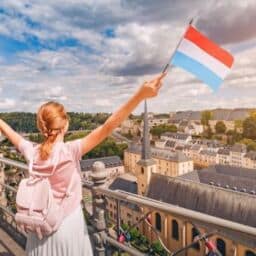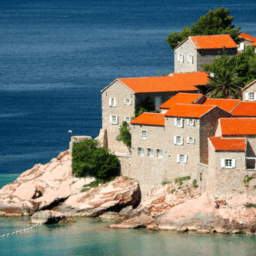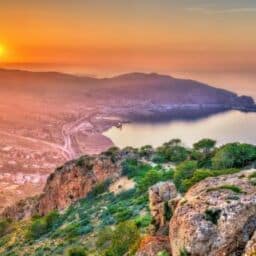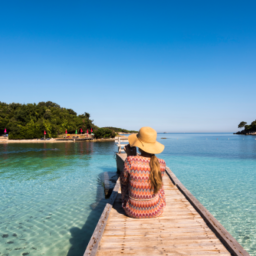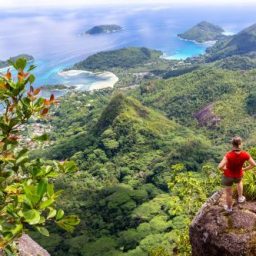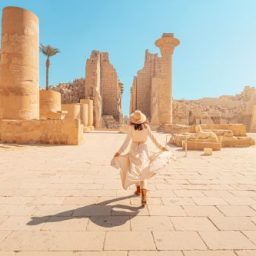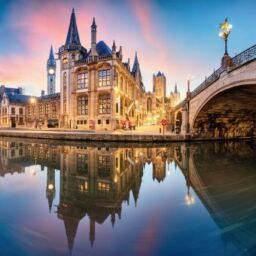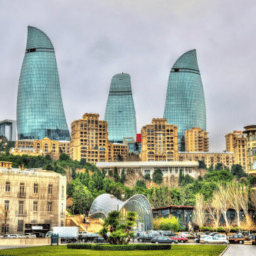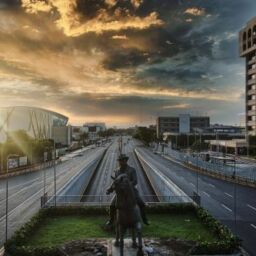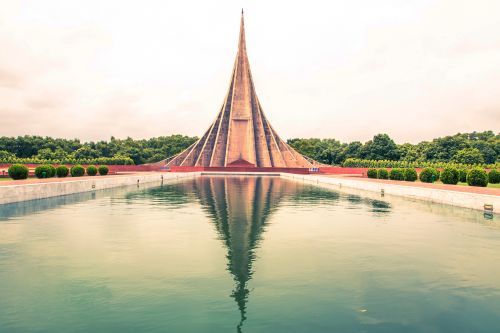

If you ever decided to check the place of origin of your clothes, you probably happened to come across information that they were made in Bangladesh. It shouldn’t be surprising, as the country is one of the most important clothing manufacturers in the world. But do you know anything else about it, would you be able to point it out on the map, or do you know what language its citizens speak? If not, it’s time to change that!
In this article, you will find not only information about the Bengali language. We talk about the country itself, its geography, history, and politics, as well as about the basic issues that must be considered before going there. Let’s start!
Bangladesh – key information
First, some basic facts about Bangladesh:
- Bangladesh is a country in southern Asia, bordering India to the east, west, and north, and Burma to the south.
- The full name of the country is the People’s Republic of Bangladesh
- The population is approximately 170 million people, making it the eighth most populous and one of the most densely populated countries in the world.
- The capital of Bangladesh is Dhaka, one of the largest cities in the world with a population of over 20 million people.
- The country suffers from overpopulation, lack of education, and poverty, as well as problems related to the quality of life of its people.
- At the same time, Bangladesh is one of the fastest growing countries in Asia, gaining importance in the global economy.
- The most important factor contributing to the economic growth of the country is the development of clothing production for export, counted in millions of dollars annually.
- Bangladesh has a rich history and culture linked to Bengal’s Muslim heritage, which has contributed to the development of arts, music, and literature in the country.
- The country suffers from climate-related problems such as cyclones, floods, and droughts, which often lead to material and human losses.
- The official language is Bengali and the majority of the population is Muslim.
Geography
Bangladesh has a flat topography, with predominantly lowland areas less than 10 meters above sea level. Located there, the delta of the Ganges, Bramaputra and Meghna covers most of the country and flows into the Bay of Bengal.
The climate in Bangladesh is hot and humid. It’s characterized by two seasons: rainy and dry. The country also experiences floods, cyclones, and droughts, which affect people’s lives and the country’s economy.
Bangladesh is home to many rivers, waterfalls, lakes, and forest areas. The country is also home to numerous wildlife such as tigers, Indian rhinos, Indian elephants, and many species of birds.
Political system
Since 1991, Bangladesh has been governed by a parliamentary democratic system, with the president as head of state and the prime minister as head of government. Executive power is located in the government, which is responsible for conducting domestic and foreign policy as well as managing the day-to-day affairs of the country.
The legislature is bicameral, consisting of the Jatiya Sangsad (Parliament) and the Rajya Sangsad (Senate). Members of Parliament are elected in universal elections every five years.
Although Bangladesh is officially recognized as a parliamentary republic, in reality political power is concentrated in the hands of the prime minister and his political party.
The country’s authorities are criticized by the international community for non-compliance with human rights and problems related to freedom of the press and freedom of speech.
Administrative division
Bangladesh is divided into eight administrative districts, called divisions, which are further subdivided into 64 districts.
Each district is governed by a deputy commissioner, who is appointed by the government and is responsible for coordinating government activities at the district level. In addition, each district is divided into sub-districts, lower administrative units, and then into so-called upazila or thana, which are the lowest administrative units.
Economy
The state’s economy is based mainly on agriculture and the clothing industry, but sectors such as tourism, fishing, IT, and the pharmaceutical industry are also being developed.
Agriculture is one of the main sectors of the economy, as it employs more than half of the working population. The main crops are rice, cereals, vegetables, tea, cotton, and jute.
The clothing industry is the second-largest sector of the economy and the country is the second-largest exporter of clothing in the world, producing clothes for many well-known international brands.
Other important industry sectors include the food, pharmaceutical, chemical, machinery, and electronics industries. The country also has natural resources such as natural gas and coal, which allows for the development of the energy industry.
In recent years, Bangladesh has also placed increasing emphasis on the development of the IT sector and outsourcing services, which contribute to the country’s economic growth. Tourism is also an important sector of the economy, with over a million tourists visiting the country each year.
Brief history of Bangladesh
Bangladesh has a long and turbulent history. The country was dominated by various powers, including the Mughal Empire and the British, before gaining independence in 1971.
In 1947, India was partitioned and Bangladesh, then known as East Pakistan, was annexed to Pakistan, but there were many struggles over the next few decades for sovereignty and equality for the Bangladeshi people who made up the majority of the population.
After a war with Pakistan that saw around three million people die, Bangladesh declared independence in 1971. Over the next few years, the country tried to rebuild its economy and infrastructure, as well as develop its culture and language.
After gaining independence, Bangladesh has experienced several military coups and other political problems. In 1991, the presidential system was replaced by a multi-party system, and since then the country has undergone many political and economic reforms.
Currently, Bangladesh is a developing country that is trying to modernize its economy and improve the living conditions of its people. The country also plays an important role in the region as a trade and strategic partner.
Official language of Bangladesh
The official language in Bangladesh is Bengali. Apart from it, several other minority languages are also used, such as Chakma, Marma, Tanchangya, Urdu, and others. English is also widely used in the business sector, public administration, and higher education.
Other than that, a small Wakhi community living mainly in the Hunza River valley in northern Pakistan has its own distinct Wakhi language.
Bengali language
Bengali is an Indo-European language spoken primarily in Bangladesh and the Indian state of West Bengal. It is also one of the most spoken languages in the world, as it is spoken by more than 250 million people.
Bengali has a separate alphabet consisting of 11 vowels and 39 consonants. It is written from left to right, and the individual letters join together to form different shapes.
Bengali has many dialects, but the most popular is the Kolkata dialect (also known as standard or literary dialect), which is used in literature, media, and public administration. Other popular dialects include: Chittagong, Rajshahi, and Sylhet dialect.
The Bengali language has a rich literature that dates back to the 11th century. Famous Bangladeshi writers include Rabindranath Tagore, who was the first Asian to be awarded the Nobel Prize in Literature, and Kazi Nazrul Islam, a famous poet and writer.
The Bengali language is an important element of Bangladeshi culture and plays a key role in shaping the national identity of the people of Bangladesh.
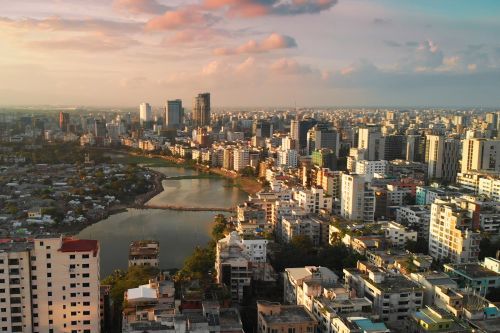


English language in Bangladesh
English is very popular in Bangladesh and is widely used in the business sector, public administration, higher education, and the media. Good knowledge of English results from several factors:
- Colonial heritage: Bangladesh was once part of British India, during this period English functioned as the language of administration and education, and the influence of the colonizers has survived to this day.
- Education: Education is very important to Bangladeshi society, and English is one of the main subjects taught in schools and universities.
- Competitiveness: In today’s global business environment, English proficiency is essential for international competitiveness. For this reason, many companies and enterprises require the knowledge of English from their employees.
- Migration: Many people from Bangladesh immigrate to English-speaking countries such as the United Kingdom, Canada, the United States, and Australia to work or study, which requires the ability to speak English.
The high knowledge of English in Bangladesh is also the result of systematic government activities aimed at improving the quality of education and developing language skills among young people.
What to see in Bangladesh? Tourist attractions
Bangladesh is a country that is quite unknown as a tourist destination. This is surprising because, despite Bangladesh being a Muslim country, the local population is known for their friendly treatment of foreigners, and there are many interesting places in the country that are worth seeing. Below are some of the most important tourist attractions:
- Cox’s Bazar – the world’s longest natural sea beach, with a length of over 120 km. It is a popular holiday destination with stunning views of the Bay of Bengal.
- Sundarbans – the world’s largest wetland mangrove forest, which is home to many species of wildlife, including Bengal tigers. The area is declared a UNESCO World Heritage Site.
- Old Town Dhaka – the capital of the state has a rich history and culture, and many architectural monuments such as mosques, palaces, and fortifications have survived to this day.
- Dhakeshwari Temple – one of the most important places of Hindu worship in Bangladesh, dating back to the 7th century. The temple is a beautiful example of Hindu architecture.
- Brahmaputra and Ganges rivers – these two great rivers flow through Bangladesh and offer great views, as well as the possibility of boat trips and visiting fishing villages.
- Kuakata – a picturesque town located on the south coast, famous for its beautiful views of the sunrise and sunset over the Bay of Bengal.
- Chittagong Hill Tracts – a mountainous area in the southeast, there are beautiful waterfalls, lakes, and national parks.
- Srimangal – a region of green tea plantations, where you can see the tea production process and enjoy beautiful views of the plantations and forests.
These places are just some of the many interesting tourist attractions in Bangladesh. The country also offers many other great places and experiences just waiting to be discovered.
Bangladesh – useful information
If you are considering a trip to Bangladesh, please read the information below. They will help you plan your trip.
General entry requirements
To enter Bangladesh, you must meet several conditions and have the appropriate documents:
- Passport: A passport that will be valid for at least 6 months from the date of departure is required.
- Visa: Citizens of most countries must have a visa before entering. It can be obtained from a Bangladesh embassy or consulate in the country of origin, and also online.
- Return ticket: Often, you may be required to present a return ticket or confirmation of your flight booking.
- Financial resources: It is required to have sufficient financial resources to cover the costs of the stay.
- Other requirements: There may also be other requirements, such as travel insurance or proof of employment.
It is worth remembering that these requirements may change, so before planning a trip it is worth checking the current information.
Local time
Bangladesh is in the UTC+6 time zone. This means that local time is 6 hours ahead of universal time. There is no summer/winter time.
Currency and finances
The currency is the Bengali taka. The currency code is BDT (Bangladeshi Taka). Taka is divided into 100 paisa. Banknotes are in circulation in denominations of 2, 5, 10, 20, 50, 100, 500, and 1000 taka, and coins in denominations of 1, 2, and 5 taka and 1, 5, 10, 25 and 50 paisa. In some places, especially tourist destinations, you can pay by credit card, but it’s a good idea to have cash with you as cards are not accepted everywhere.
Insurance
In accordance with the current regulations, entry to Bangladesh does not require travel insurance or other forms of insurance. Nevertheless, it is recommended that every tourist visiting Bangladesh have valid travel insurance covering the costs of treatment, hospitalization, medical transport, and accident insurance.
It is worth remembering that medical care in Bangladesh may differ from Western standards, and some diseases encountered in this part of the world (such as malaria or dengue fever) require special treatment.
Health and vaccinations
There are no compulsory vaccinations, but vaccinations against polio, hepatitis A+B, meningococcal A+B, tetanus, and diphtheria are recommended.
Public transport
Different forms of public transport are available in Bangladesh, depending on the city and region. The most commonly used means of transport are:
- Rickshaws
- Coaches
- Taxis
- Trains
- Ships
Driving licence
Tourists with an international driving licence can rent a car. Nevertheless, due to the specific road conditions and local driving style, driving in Bangladesh can be pretty difficult and frustrating.
Roads are also often not in the best technical condition, and drivers not alway respect traffic rules. It is also worth remembering that the traffic there is left-handed, which may be an additional difficulty for some tourists.
Diplomatic representation
When you are staying in a foreign country, the embassy and consulate are important places to know about. Even though you may not require their assistance, it is advisable to be aware of how to contact them in case of need. Before your trip, take some time to research and locate information about your country’s diplomatic post.
Languages of the world with Skrivianek
Knowledge of English is undoubtedly an asset in foreign countries, including Bangladesh. But why stop at just English, when you can learn any language you want? Not only it will help you on your journeys, but it will also prove useful in the labour market, especially in international companies.
If you are having a hard time learning on your own consider taking a language course, such as the ones offered by Skrivianek and your language skills will surely improve. We also offer translation services in numerous language combinations. Check out our full offer on our website!


